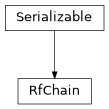Radio-Frequency Chain¶

The RF chain model is used to simulate the impairments of the RF front-end of a wireless device. During simulation runtime, the RF chain configuration is applied to the signal before transmission over the air and after reception before further processing. More specifically, during transmission, the base-band samples to be transmitted are initially converted to the analog domain by a digital-to-analog converter, followed by modeling mixer impairments (I/Q imbalance and phase noise), and finally by a power amplifier:
graph LR
dac[DAC] --> iq[I/Q] --> pn[PN] --> pa[PA]
During reception, the received signal is first amplified by a low-noise amplifier, followed by mixer impairments (I/Q imbalance and phase noise), and finally converted to the digital domain by an analog-to-digital converter:
graph LR
lna[LNA] --> pn[PN] --> iq[I/Q] --> adc[ADC]
- class RfChain(phase_offset=None, amplitude_imbalance=None, adc=None, power_amplifier=None, phase_noise=None)[source]¶
Bases:
SerializableRadio-frequency (RF) chain model.
- Parameters:
amplitude_imbalance (
float|None) – I/Q amplitude imbalance.adc (
AnalogDigitalConverter|None) – The analog to digital converter at the end of the RF receive chain. If not specified, ideal analog-to-digital conversion introducing no additional noise is assumed.power_amplifier (
PowerAmplifier|None) – The power amplifier at the beginning of the RF transmit chain. If not specified, ideal linear power amplification is assumed.phase_noise (
PhaseNoise|None) – Phase noise model configuration. If not specified, an ideal oscillator introducing no phase noise is assumed.
- classmethod Deserialize(process)[source]¶
Deserialize an object’s state.
Objects cannot be deserialized directly, instead a
Factorymust be instructed to carry out the deserialization process.- Parameters:
process (
DeserializationProcess) – The current stage of the deserialization process. This object is generated by theFactoryand provides an interface to deserialization methods supporting multiple backends.- Return type:
- Returns:
The deserialized object.
- add_iq_imbalance(input_signal)[source]¶
Adds Phase offset and amplitude error to input signal.
Notation taken from https://en.wikipedia.org/wiki/IQ_imbalance.
- Parameters:
input_signal (
ndarray) – Signal to be deteriorated as a matrix in shape #no_antennas x #no_samples. #no_antennas depends if on receiver or transmitter side.- Return type:
Returns: Deteriorated signal with the same shape as input_signal.
- receive(input_signal)[source]¶
Returns the distorted version of signal in “input_signal”.
According to reception impairments.
- Return type:
- serialize(process)[source]¶
Serialize this object’s state.
Objects cannot be serialized directly, instead a
Factorymust be instructed to carry out the serialization process.- Parameters:
process (
SerializationProcess) – The current stage of the serialization process. This object is generated by theFactoryand provides an interface to serialization methods supporting multiple backends.- Return type:
- transmit(input_signal)[source]¶
Returns the distorted version of signal in “input_signal”.
According to transmission impairments.
- Return type:
- property adc: AnalogDigitalConverter¶
The analog to digital converter at the end of the RF receive chain.
- property amplitude_imbalance: float¶
I/Q amplitude imbalance.
- Raises:
ValueError – If the imbalance is less than zero or more than one.
- property phase_noise: PhaseNoise¶
Phase Noise model configuration.
- property power_amplifier: PowerAmplifier | None¶
Access the represented radio-frequency chain’s power amplifier A handle to the PowerAmplifier.
Isolation model (to be implemented): Kiayani et al.[1]